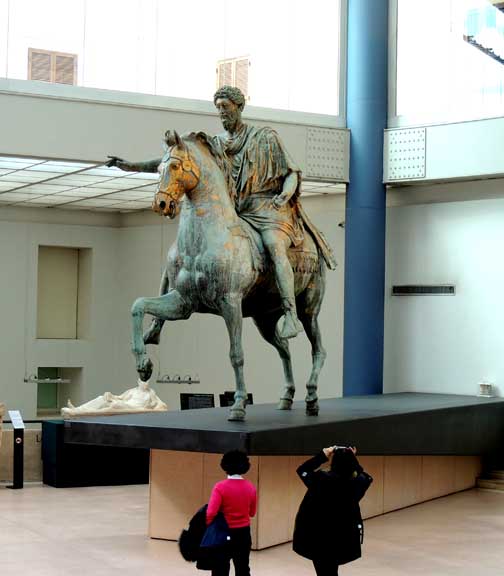Capitoline Museums................ Architecture Around the World
2013 photos
Capitoline Museums
(Pronounced KAP i tow line)
Rome, Italy
On this page, below:
Michelangelo Buonarroti portrait sculpture
Colossus of Emperor Constantine the Great
Marcus Aurelius Enters Rome relief
Marcus Aurelius Shows Clemency relief
The Equestrian Statue of Marcus Aurelius
| The Capitoline Museums are a group of art and archeological museums in Piazza del Campidoglio, on top of the Capitoline Hill in Rome, Italy. The museums are contained in three palazzi
[palaces] surrounding a central trapezoidal piazza in a plan conceived
by Michelangelo Buonarroti in 1536 and executed over a period of more
than 400 years. The history of the museums can be traced to 1471, when Pope Sixtus IV donated a collection of important ancient bronzes to the people of Rome and located them on Capitoline Hill. The museums are owned and operated by the municipality of Rome. The captions below were culled from Musei Capitolini (online March 2013). |
Michelangelo Buonarroti portrait sculpture Michelangelo Buonarroti portrait sculpture, by Daniele da Volterra. Daniele da Volterra was a talented artist who studied in Rome under Michelangelo. He was profoundly influenced by the famous artist and became his good friend. After his teacher's death, Daniele was assigned by Pope Paul IV to paint in draperies to cover the nudity of figures in Michelangelo's "Last Judgment" in the Sistine Chapel. |
Colossus of Emperor Constantine the Great Colossus of Emperor Constantine the Great (c. 280–337) The Colossus was pillaged sometime in Late Antiquity, most likely for the bronze body portions. The marble portions of the statue were brought to light in 1487. The surviving remnants were later removed from the Forum Basilica and placed in the nearby Palazzo dei Conservatori Courtyard by Michelangelo, who was working in the area.  Colossus of Emperor Constantine the Great The head, arms and legs of the 40 ft. high Colossus were carved from white marble, while the rest of the body consisted of a brick core and wooden framework, possibly covered with gilded bronze.  Colossus of Emperor Constantine the Great  Colossus of Emperor Constantine the Great |
Marcus Aurelius Enters Rome Marcus Aurelius Enters Rome On a chariot drawn by four horses, Marcus Aurelius enters Rome accompanied by a winged Victory. This relief is probably from a triumphal arch dedicated to Marcus Aurelius on the occasion of his victories over the Sarmatians and the Germans in 176 AD.  Marcus Aurelius Enters Rome  Detail - Marcus Aurelius Enters Rome |
Marcus Aurelius Shows Clemency Marcus Aurelius Shows Clemency On horseback, wearing military uniform, Marcus Aurelius Shows Clemency with his right arm outstretched, a gesture of clemency towards kneeling barbarian prisoners. This relief, like the one illustrated above, is probably from a dedicated to Marcus Aurelius on the occasion of his victories over the Sarmatians and the Germans in 176 AD.  Detail - Marcus Aurelius Shows Clemency |
The Equestrian Statue of Marcus Aurelius Marcus Aurelius The statue was erected in 175 CE. Its original location is debated. Although there were many
equestrian imperial statues, they rarely survived because it was
practice to melt down bronze statues for reuse as coin or new
sculptures in the late empire. Statues were also destroyed because
medieval Christians thought that they were pagan idols. The statue of
Marcus Aurelius was not melted down because in the Middle Ages it was
incorrectly thought to portray the first Christian Emperor Constantine.
Indeed, it is the only fully surviving bronze statue of a pre-Christian
Roman emperor.
In the medieval era it was one of
the few Roman statues to remain on public view. In the 8th century it
stood in the Lateran Palace in Rome, from where it was relocated in
1538 to the Piazza del Campidoglio (Capitoline Hill) during
Michelangelo's redesign of the Hill. Though he disagreed with its
central positioning, he designed a special pedestal for it. The
original is on display in the Palazzo dei Conservatori of the Musei
Capitolini - photo above, but on a pedestal NOT designed by
Michelangelo.
The one now standing in the open air of the Piazza del Campidoglio (photos) is a replica made in 1981 when the original was taken down for restoration.  Marcus Aurelius  Marcus Aurelius The statue was formerly clad in gold.  Marcus Aurelius |
